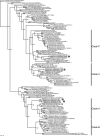The Cryptococcus neoformans catalase gene family and its role in antioxidant defense
- PMID: 16963629
- PMCID: PMC1563583
- DOI: 10.1128/EC.00098-06
The Cryptococcus neoformans catalase gene family and its role in antioxidant defense
Abstract
In the present study, we sought to elucidate the contribution of the Cryptococcus neoformans catalase gene family to antioxidant defense. We employed bioinformatics techniques to identify four members of the C. neoformans catalase gene family and created mutants lacking single or multiple catalase genes. Based on a phylogenetic analysis, CAT1 and CAT3 encode putative spore-specific catalases, CAT2 encodes a putative peroxisomal catalase, and CAT4 encodes a putative cytosolic catalase. Only Cat1 exhibited detectable biochemical activity in vitro, and Cat1 activity was constitutive in the yeast form of this organism. Although they were predicted to be important in spores, neither CAT1 nor CAT3 was essential for mating or spore viability. Consistent with previous studies of Saccharomyces cerevisiae, the single (cat1, cat2, cat3, and cat4) and quadruple (cat1 cat2 cat3 cat4) catalase mutant strains exhibited no oxidative-stress phenotypes under conditions in which either exogenous or endogenous levels of reactive oxygen species were elevated. In addition, there were no significant differences in the mean times to mortality between groups of mice infected with C. neoformans catalase mutant strains (the cat1 and cat1 cat2 cat3 cat4 mutants) and those infected with wild-type strain H99. We conclude from the results of this study that C. neoformans possesses a robust antioxidant system, composed of functionally overlapping and compensatory components that provide protection against endogenous and exogenous oxidative stresses.
Figures







References
-
- Adachi, J., and M. Hasegawa. 1996. MOLPHY version 2.3, programs for molecular phylogenetics based on maximum likelihood. The Institute of Statistical Mathematics, Tokyo, Japan.
-
- Altschul, S. F., W. Gish, W. Miller, E. W. Myers, and D. J. Lipman. 1990. Basic local alignment search tool. J. Mol. Biol. 215:403-410. - PubMed
Publication types
MeSH terms
Substances
Associated data
- Actions
- Actions
- Actions
- Actions
Grants and funding
LinkOut - more resources
Full Text Sources
Medical
Molecular Biology Databases
Miscellaneous

